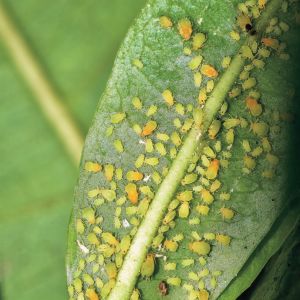Understanding Aphids, Their Behavior, and Effective Control Methods
Aphids, bugs in the superfamily Aphidoidea, sometimes known as plant lice, are among the most common garden pests worldwide. These tiny, soft-bodied insects are notorious for their ability to reproduce rapidly and damage a wide range of plants, from ornamental roses to essential food crops. Though small in size, aphids can have a significant impact on the health and productivity of gardens, farms, and landscapes.
Physical Characteristics and Life Cycle
Aphids are typically 1-10 mm long and come in a variety of colors, including green, black, yellow, brown, and pink. Their pear-shaped bodies feature long antennae, and many species have two tube-like structures called cornicles protruding from their abdomen.
Cornicles are a key feature of aphids, and they are usually prominent. They look like a pair of tailpipes on their rear (abdomen), sometimes darker than the body color. Aphids can reproduce both sexually and asexually, allowing them to multiply rapidly, especially in favorable conditions. Some aphids are winged, which helps them spread to new plants, while others remain wingless. A straw-like mouthpart, called a proboscis, contains needle-like stylets that are used to tap into the phloem (plant vessels that transport sap around the plant)
Developmental Stages
 Throughout these phases, aphids pass through several nymphal stages (instars) before reaching adulthood:
Throughout these phases, aphids pass through several nymphal stages (instars) before reaching adulthood:
- Nymph Stage: Newly born nymphs resemble small adults but without wings and reproductive organs.
- Molting: Nymphs molt about four times as they grow bigger.
- Adult Stage: After the final molt, aphids become sexually mature adults capable of reproduction.
The aphid life cycle is unique. In spring and summer, most aphids give birth to live young, bypassing the egg stage to speed up population growth. When environmental conditions change, such as in the fall, aphids may lay eggs that survive winter to hatch in the spring. The good news is that aphids tend to move rather slowly and, with diligent care, can be controlled.
Social Behavior
Aphid colonies often exhibit social behaviors that enhance their survival:
- Aggregation: Aphids tend to cluster together on host plants where they feed collectively. This aggregation provides some protection against predators but also increases competition for resources.
- Alarm Signals: When disturbed or threatened by predators, some aphid species release alarm pheromones that alert nearby colony members to danger, prompting them to flee or adopt defensive postures.
- Mutualistic Relationships: Ants are known to farm aphids for their honeydew secretions; in return for this sugary reward, ants protect aphid colonies from natural enemies like ladybugs or parasitic wasps.
Adoptions for Survival
- Camouflage: Many aphid species have coloration patterns that blend them into their surroundings or mimic other natural elements like flower buds or leaves.
- Wing Development: The ability to produce winged individuals allows aphid colonies to disperse when resources become limited or when predation pressure increases.
- Resistance Mechanisms: Certain aphid species have developed resistance mechanisms against insecticides due to genetic variations within their populations.
Feeding Habits and Plant Damage
Aphids feed using their straw-like mouthparts by piercing plant tissues and sucking out the sap. This feeding method weakens plants, causing distorted leaves, yellowing, stunted growth, and sometimes plant death. As aphids feed, they excrete a sticky substance called honeydew, which attracts ants and promotes the growth of sooty mold, further harming plants and reducing their aesthetic and economic value.
Early detection can be a challenge, as they are often located in less visible places. Your plants likely have aphids if you notice:
- Aphid colonies
- Aphid eggs
- Stickiness
- Shiny film
- Dark sooty mold
- Curled leaves
- Yellowed leaves
- Stunted growth
A few aphid species create leaf galls. Galls are abnormal tissue swellings in a plant. Since they feed inside of a gall that forms around them, the aphids are not directly visible. The host plant and gall’s appearance help to identify the aphid responsible. One example is the witchhazel cone gall aphid. Leaf galls typically only cause aesthetic damage and do not significantly harm the health of the plant.
Aphids as Vectors of Disease
Most plant viruses are dependent on vectors for their transmission and survival. Beyond direct damage, aphids are important vectors for plant viruses. As they move from plant to plant, they can transmit diseases that may stunt growth, reduce yields, or kill crops. This makes controlling aphid populations a priority for gardeners and farmers alike.
Natural Enemies and Biological Control
Many predatory insects and songbirds eat aphids and help to lower their populations naturally. Aphids have many natural predators, including ladybugs (ladybird beetles), lacewings, parasitic wasps, and hoverfly larvae. Encouraging these beneficial insects in the garden can help keep aphid populations in check. Birds and spiders also feed on aphids, contributing to their natural control.
Many beneficial insects prey on aphids naturally:
- Lady Beetles (Ladybugs): Both adult and larval ladybugs voraciously consume aphids.
- Lacewings: Lacewing larvae are excellent aphid predators.
- Hoverflies: Their larvae feed on aphids while adults pollinate flowers.
- Parasitic Wasps: Tiny wasps lay eggs inside aphids; the emerging larvae kill the host.
You can attract these beneficial insects by planting diverse flowering plants such as dill, fennel, yarrow, cosmos, marigold, and daisies near your garden.
Prevention and Management Strategies
- Monitoring: Regularly inspect plants for aphids, especially the undersides of leaves and new growth. Ants are often associated with aphid populations, especially on trees and shrubs, and frequently are a clue that an aphid infestation is present
- Physical Removal: For small infestations, gently wash aphids off plants with a strong stream of water or squash them by hand.
- Biological Control: Attract or release natural predators, such as ladybugs, into your garden.
- Cultural Practices: Avoid excessive nitrogen fertilization, which can promote succulent growth favored by aphids. Rotate crops and remove weeds that may harbor aphids. Systemic insecticides are absorbed into the plant sap from foliage or root applications.
Insecticides
Low-toxicity insecticides include horticultural oil and insecticidal soap (these types of pesticides may go by a variety of brand or trade names).
Systemic insecticides are absorbed into the plant sap from foliage or root applications. Keep in mind this category of insecticide may risk harming pollinators visiting flowers if a plant blooms soon after treatment. How long a systemic chemical remains in the plant’s tissues can vary and is not always known.
How to Discourage Aphids
Support predators and parasitoids (natural enemies) by increasing plant species and structural diversity (layers like trees, shrubs, groundcovers) in your landscape. Ensure that your landscape has sources of nectar through all growing seasons, since many predators and parasitoids feed on nectar and pollen. These natural enemies are also sensitive to pesticides. Limit pesticide use to protect this natural source of sustainable pest management.
Avoid over-fertilizing plants, especially with nitrogen. Excess nitrogen promotes rapid, tender growth which is often more attractive to aphids and other insect pests. Research has shown that high nitrogen levels in plant tissue can increase susceptibility to pest attacks. (Explore more about the Impacts of Fertilizers on Insect Pests.)
Minimize plant stress by watering when needed and not growing vulnerable plants in locations subjected to reflected heat or reduced air circulation. Crowded plantings may also be more vulnerable to aphid outbreaks and may help aphids to spread more quickly.
Remove weeds from garden areas so they do not harbor aphids or diseases that aphids can transmit.
Apply row cover around seedlings and vegetable transplants to reduce aphid and other pest damage. Remove the cover when the plant begins to flower to allow for pollination. (Not all vegetable plants will need to be pollinated.)
Conclusion
Aphids may be tiny, but their presence can lead to big problems in gardens and farms. By understanding their biology, behavior, and natural enemies, it is possible to implement effective strategies for managing these pests. Integrated approaches that combine monitoring, physical removal, biological control, and careful use of chemicals can help protect plants and promote a healthy, balanced ecosystem.
Aphids in Home Gardens | University of Maryland Extension
Aphids Management Guidelines–UC IPM
Integrated Pest Management (I.P.M.) for Aphids | Home & Garden Information Center
By Master Gardener, September Sickinger

